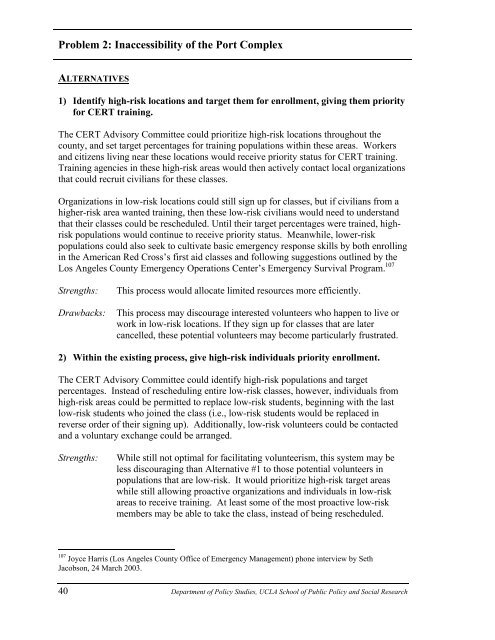Port Security Applied Policy Project - Belfer Center for Science and ...
Port Security Applied Policy Project - Belfer Center for Science and ...
Port Security Applied Policy Project - Belfer Center for Science and ...
Create successful ePaper yourself
Turn your PDF publications into a flip-book with our unique Google optimized e-Paper software.
Problem 2: Inaccessibility of the <strong>Port</strong> Complex<br />
ALTERNATIVES<br />
1) Identify high-risk locations <strong>and</strong> target them <strong>for</strong> enrollment, giving them priority<br />
<strong>for</strong> CERT training.<br />
The CERT Advisory Committee could prioritize high-risk locations throughout the<br />
county, <strong>and</strong> set target percentages <strong>for</strong> training populations within these areas. Workers<br />
<strong>and</strong> citizens living near these locations would receive priority status <strong>for</strong> CERT training.<br />
Training agencies in these high-risk areas would then actively contact local organizations<br />
that could recruit civilians <strong>for</strong> these classes.<br />
Organizations in low-risk locations could still sign up <strong>for</strong> classes, but if civilians from a<br />
higher-risk area wanted training, then these low-risk civilians would need to underst<strong>and</strong><br />
that their classes could be rescheduled. Until their target percentages were trained, highrisk<br />
populations would continue to receive priority status. Meanwhile, lower-risk<br />
populations could also seek to cultivate basic emergency response skills by both enrolling<br />
in the American Red Cross’s first aid classes <strong>and</strong> following suggestions outlined by the<br />
Los Angeles County Emergency Operations <strong>Center</strong>’s Emergency Survival Program. 107<br />
Strengths: This process would allocate limited resources more efficiently.<br />
Drawbacks: This process may discourage interested volunteers who happen to live or<br />
work in low-risk locations. If they sign up <strong>for</strong> classes that are later<br />
cancelled, these potential volunteers may become particularly frustrated.<br />
2) Within the existing process, give high-risk individuals priority enrollment.<br />
The CERT Advisory Committee could identify high-risk populations <strong>and</strong> target<br />
percentages. Instead of rescheduling entire low-risk classes, however, individuals from<br />
high-risk areas could be permitted to replace low-risk students, beginning with the last<br />
low-risk students who joined the class (i.e., low-risk students would be replaced in<br />
reverse order of their signing up). Additionally, low-risk volunteers could be contacted<br />
<strong>and</strong> a voluntary exchange could be arranged.<br />
Strengths: While still not optimal <strong>for</strong> facilitating volunteerism, this system may be<br />
less discouraging than Alternative #1 to those potential volunteers in<br />
populations that are low-risk. It would prioritize high-risk target areas<br />
while still allowing proactive organizations <strong>and</strong> individuals in low-risk<br />
areas to receive training. At least some of the most proactive low-risk<br />
members may be able to take the class, instead of being rescheduled.<br />
107 Joyce Harris (Los Angeles County Office of Emergency Management) phone interview by Seth<br />
Jacobson, 24 March 2003.<br />
40 Department of <strong>Policy</strong> Studies, UCLA School of Public <strong>Policy</strong> <strong>and</strong> Social Research
















